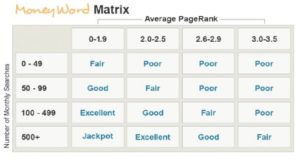Competition Analysis
 While several popular methods are offered here, Competition Analysis should be more about gauging the strength of the competition as opposed to the number of competitors.
While several popular methods are offered here, Competition Analysis should be more about gauging the strength of the competition as opposed to the number of competitors.
Choose ONE Competition Analysis method from A, B, C, or D below:
- A. Competition analysis for Keywords using tools such as Traffic Travis or Market Samurai.
- Ditch Keywords with Authority sites occupying all the top spots. (Wikipedia, WebMD, cnn, etc.)
- Ditch Keywords that have >1000 page backlinks to most of the top spots.
- Ditch Keywords that don’t have at least one competing URL with less than 1 year of Domain Age on page one of Google.
- B. Competition analysis for Keywords with Google. (Gary Gregory’s “M.O.B.S.” method.)
- Search “MainKeyword” (in quotes), ditch Keywords that return more than 75,000 results. (use 30,000 for internal pages.)
- Then use allintitle:MainKeyword (without quotes) ditching Keywords that give more than 20,000 results. (use 10,000 for internal pages.)
- C. Competition analysis for Keywords with Google. (Dan Tan’s “True Measure” method.)
- Do a keyword search (in quotes) and navigate to the last page of listings. (Add &start=990 to the end of the URL.)
- Ditch Keywords that have already shown 700 or more results.
- Think hard before accepting words that have already shown more than 500 results.
- Keywords intended for ‘Inner pages’ use should have fewer than 300-400 results shown.
UPDATE: As of 4/15/16, Google has announced PageRank Will No Longer Be Available
-
D. Competition analysis for Keywords with Google. (Adam Short and Alan Sultanic “MoneyWord Matrix” method.) Do a Keyword search (in quotes) and calculate the average Page Rank for the top ten listings on page one.Ditch Keywords that have an average PR >3.0.Ditch Keywords that have average PR >2.5. if searches are <5000 LMS.Ditch Keywords that have average PR >=2.0. if volume is <1000 LMS.The best Keywords will have an average PR <2.0. and the search volume is >=5000 LMS.
A simple 3 step system to evaluate the competition that manages to incorporate the main ideas behind the methods given above is as follows:
Step 1) Take the average page rank of each of the top 10 sites. There are plenty of free tools to figure out page rank. Do you remember installing the SEO Quake add-on to your browser? So, you add up the page rank of the 10 sites, and divide by 10 to get your average page rank. Record the average page rank.- Step 2) Goolge your keyword like this. allintitle:keyword. (Without quotes!) and note the results. This gives you how many people have this in their Title. (competitors trying to rank!).
There is a keyword selection method known as Keyword Golden Ratio which recommends that you divide the number of results here by the average monthly searches. If the quotient is =< 0.25, you have found a KGR keyword phrase. This works best for phrases with less than 250 monthly searches.
Step 3) If your average page rank is 2 or less, with fewer than 1000 results in title, you can confidently enter this market more often than not and know that ranking shouldn’t be difficult.However, If you get an average page rank of 2.5 and above, and in title results are in the five figures, you have an extremely tough market to enter!
OK. Do you have your list of low competition keywords completed? Let’s go make our Final Keyword Selection then.







